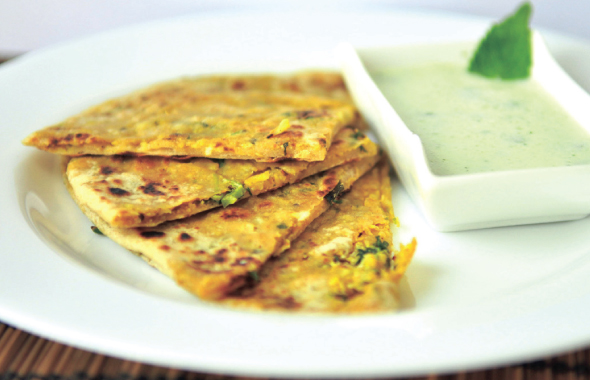Mama’s Punjabi Recipes – Gobi da Parantha (Cauliflower Parantha)
Everyone has a favorite type of Punjabi parantha, although some, like aloo (potato) paranthas have become quite common all over India and even crossed over into other regional cuisines. Some special paranthas are still very much Punjabi delicacies, like the phul gobi (cauliflower), mooli (white radish) or gajjar (carrot) ones, all of which require better preparation and careful cooking.
Stuffed paranthas are quite heavy to eat and are like vegetarian stuffed pizzas. The secret to making them is to make sure the dough is fully cooked and both sides are crispy with oil coated on it (in the old days, and to this day in the countryside, they still use fresh butter) while the parantha is still on the tava (flatplate).
Phul gobi paranthas are probably the most favorite type for Punjabis but certainly not the cheapest as the vegetable itself is quite expensive. These require careful cooking but the results are wonderful as many people will eat these with yogurt alone.
Ingredients:
500gm kanak (gehon) ka atta (wheat flour)
1 medium phul gobi (cauliflower)
1 1/2 cups pani (water)
Some tael (olive oil or vegetable oil) for coating the paranthas while cooking
Spices to taste: namak (salt), mirch (red pepper), dhania (coriander powder), garam masala, ajawain (carom seeds)
Directions:
1. Carefully clean the phul gobi with a wet paper towel. Do not wash the gobi as it will retain water between its stems and it will be absorbed into the filling mixture.
2. Cut the gobi into to smaller quarters to allow for easier shredding. If the gobi is small, there is no need to quarter it as it can be shredded easily.
3. On a hand shredder, rub the tops of the gobi and shred all the way down to the central stalk.
4. Mix in all the spices into the shredded gobi, except for the salt as it will cause the gobi to shed water and the atta will become too soft to roll or cook.
5. Pour the atta into a bowl, then slowly pour only enough of the water in while kneading the dough till it becomes a nice, round, tender firm ball. Dab the surface of the dough ball with a little water to keep it moist, cover the bowl and set aside for 10 minutes.
6. Pinch off a portion of the dough and make into a 2 inch round ball. Pour a little dry flour on the counter and roll the ball in it to coat it. Make the dough into small paade (balls). Now use a velna (rolling pin) to roll the ball into a nice round, flat 8 to 10 inch pancake, about 1/8 inch thick.
7. Now place a tablespoon of the gobi mixture in the center, add a pinch of salt and garb the edges to pinch off the dough into a ball. Carefully roll the ball into a flat pancake so that the gobi does not pierce the flour.
8. Put a small dab of oil on a hot tava (hotplate or skillet) and place the flattened dough on. When it turns color a little, turn the pancake over. Put another dab of oil on the tava and then turn it over again till it is fully cooked. When the paranthas have some dark brown spots on them, it means they are cooked.
9. Try these with a dollop of butter on the top of the warm parantha or with plain yogurt or achaar for best taste.
MAMA’S TIP OF THE WEEK
KEEP ATTA FOR ROTIS AND PARANTHAS FIRM
Use whole wheat atta (flour) for good thickness, texture and taste so that each piece of roti or parantha can be made into a wedge to scoop up raita (yogurt sauce) and curries. Some restaurants use maida (finely milled, bleached wheat flour resembling cake flour) to make paranthas and rotis but these come out rubbery and elastic, which make them tough to eat and even tougher to digest. Finally, the atta should not be thin with added water else the rotis and paranthas will be too soft and will fall apart while cooking.
Shakuntla Malhotra is a skilled cook of Punjabi dishes made in the old-fashioned style that she learnt as a young woman in her ancestral home in Lyallpur, India before it became part of Pakistan after the Partition in 1947. People have often admired her cooking for its simplicity and taste that comes with each mouthful. Even in her mid-eighties, she continues to cook daily and agreed to share some of her delectable Punjabi recipes.


